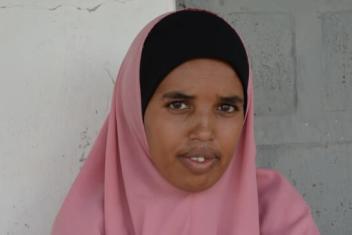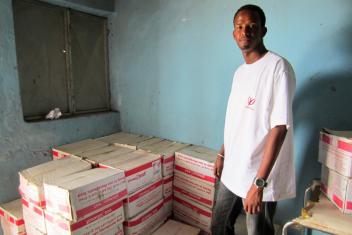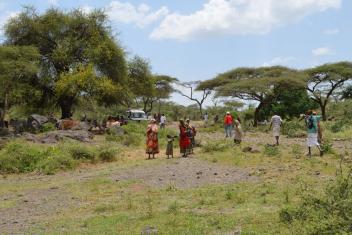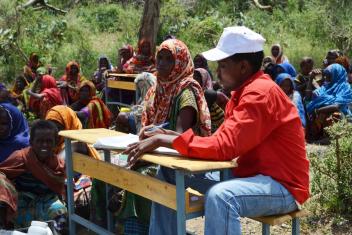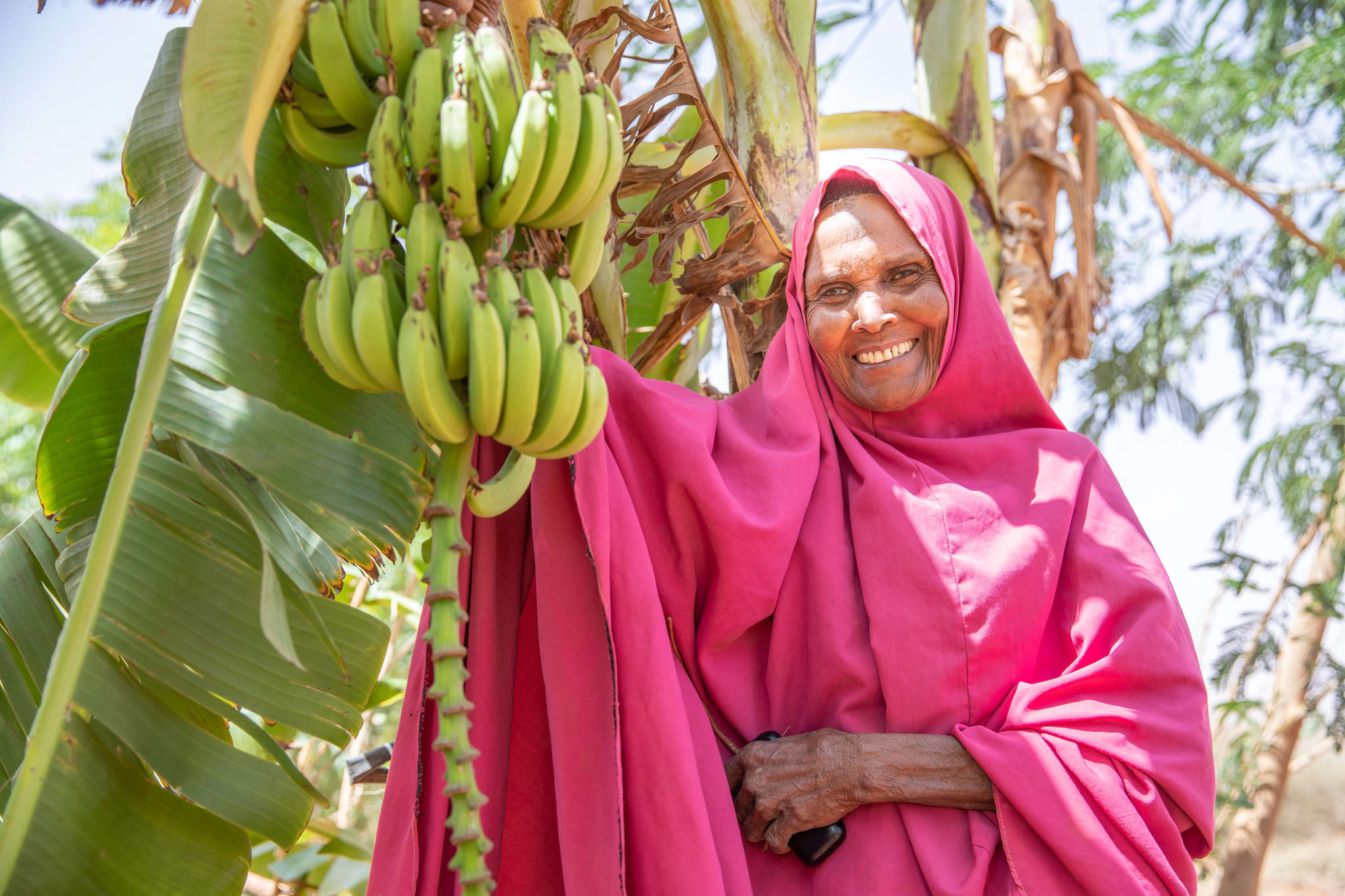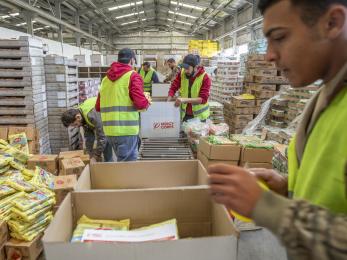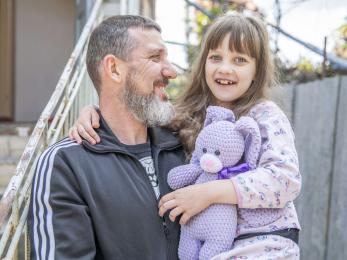From hungry to healthy: Saving children in the Horn of Africa
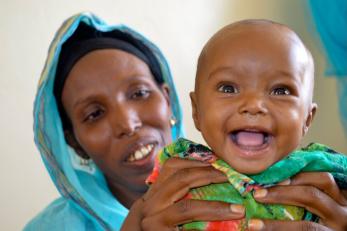
A year ago, 6-month-old Hawa Mumin was a hungry, listless baby, one of many children in Ethiopia facing hunger from food shortages in the region.
An orphan, Hawa and her seven siblings are in the care of their aunt, Nima Hassan, who already has four children of her own. With limited resources and no access to traditional medical care in their remote village, Nima struggles to provide for her large family.
When baby Hawa became ill and stopped eating, Nima brought her to Mercy Corps’ mobile health clinic for help. “All I hope is that my children will be educated and get enough food,” she told our staff at the time.
They diagnosed Hawa with severe acute malnutrition — the most critical stage of malnutrition — and rushed her to a stabilisation centre for emergency care. With around-the-clock treatment, Hawa recovered, and with supplemental food sent home with her aunt, is healthy and smiling today.
The hunger cycle
Nima’s family is one of millions still affected by the hunger crisis in the Horn of Africa, which began in 2010 when droughts parched the region and left 12.5 million people at risk of starvation.
People living in remote areas of the Horn, like Ethiopia’s easternmost Somali Region, were hit hardest. Most people who live here are pastoralists — mobile communities whose lives revolve around the weather. They are constantly on the move in search of water and pasture for their livestock, which they depend on for food, milk and income.
If rain doesn’t come, pastures dry up and animals have nothing to eat. Many get sick and die. Malnourished animals cannot produce meat and milk to sustain their owners, nor can they even be sold as a last resort for enough money to buy food in the markets. Families grow hungry and have no other means to provide for themselves.
As rain patterns become more and more unpredictable, pastoralists’ livelihoods are increasingly at risk. And when water didn’t fall in the Somali Region for several years, it devastated them.
Response to crisis is not a quick fix
At the beginning of the crisis, we helped build wells in drought-stricken villages in the region, and saved hundreds of thousands of livestock with emergency vaccinations. Years later, we’re still helping the same communities rebuild and become more resilient to future droughts.
But a crisis like this does not simply end when the next rains come. It takes years for pastures to recover, and especially in remote areas, people are still struggling with not enough food. That’s why we’ve used our mobile health programme to provide emergency food and medical treatment to people in the country’s most hard-to-reach places.
Our mobile health teams — two nurses, a nutritionist and a driver — arrive at rural villages in a vehicle stocked with supplies to treat malnutrition, address basic health concerns and provide nutrition education. Although the mobile units stop in each location for only one day at a time, they will see up to 150 patients — over half of them children.
Regardless of their ailment, every pregnant or nursing mother and child under five who visits the mobile unit is screened for malnutrition. Because they are growing and developing, mothers and young children have increased nutritional needs — and the affects of malnutrition are particularly devastating. When not fatal, it still complicates childbirth, stunts physical and cognitive development, and increases the risk of other illnesses.
If diagnosed as malnourished, mothers and children are given emergency food like Plumpy’nut, a sweet, high-protein paste made from peanuts, and corn-soy cereal to eat until they reach a healthy weight.
Since January 2012, with the help of almost $700,000 in funding through DC Entertainment’s We Can Be Heroes campaign, we have screened over 70,000 mothers and children in the Somali Region for malnutrition. Almost half of them received lifesaving treatment.
Establishing a sustainable solution
But emergency food is not enough. During the mobile health visits, we teach families about the importance of breastfeeding, the value of a balanced diet and how to care for malnourished children.
We also train individuals from each village as community health volunteers. The volunteers learn simple activities that promote good health, like how to identify a malnourished child. This education develops health leaders within the communities and helps migrant groups sustain proper nutrition even after they’ve moved on from the programme.
We have also worked hard to build a network of government health workers who will eventually lead the initiative of providing nutrition services to Ethiopians in rural areas. We work closely with the regional government to train staff in the stabilisation centres where critically malnourished patients are treated. And we take government health workers on one-month rotations with our mobile units for hands-on training in treating malnutrition in remote regions.
Fardosa Aden, 25, is the nurse who saved malnourished baby Hawa. She completed her rotation with the mobile health unit and returned to work in the mother/child health unit at one of the stabilisation centres. It was there that she and her team treated Hawa with fortified milk every two hours until the baby gained her strength back.
Our combined efforts have led to countless saved lives, more educated citizens and a stronger relationship between rural communities and traditional health services. Last month, the Ethiopian government, supported by UNICEF, announced they met Millennium Development Goal no. 4 two years early — reducing the mortality rate of children under five by two-thirds.
This goal could not have been accomplished without addressing malnutrition, a leading cause of death for children under five in the country.
Working toward a future without hunger
Emergency food saves lives that are in immediate danger, but improved food security is the only lasting solution for people in rural areas of the Horn. It is the current lack of food security — livelihoods that rely on unpredictable weather patterns, limited sources of food, poverty — that makes hunger an enduring threat in these regions.
When people are hungry they are unable to work, forced instead to walk incredible distances for food and water. Weak and tired, children miss school or drop out altogether to help support their families.
So, in tandem with our emergency food efforts, we are building resilience against food insecurity with programmes that teach pastoralists how to adapt their land use to climate change and improve the productivity of their livestock.
And for the younger generation choosing to transition out of pastoralism, we provide basic skills training, including literacy and technical training, to better prepare them to take on alternative trades.
Our goal is to provide those most vulnerable with support that will give them the knowledge and versatility to withstand the changing landscape — and make them stronger, self-sustaining people in the face of hunger.
